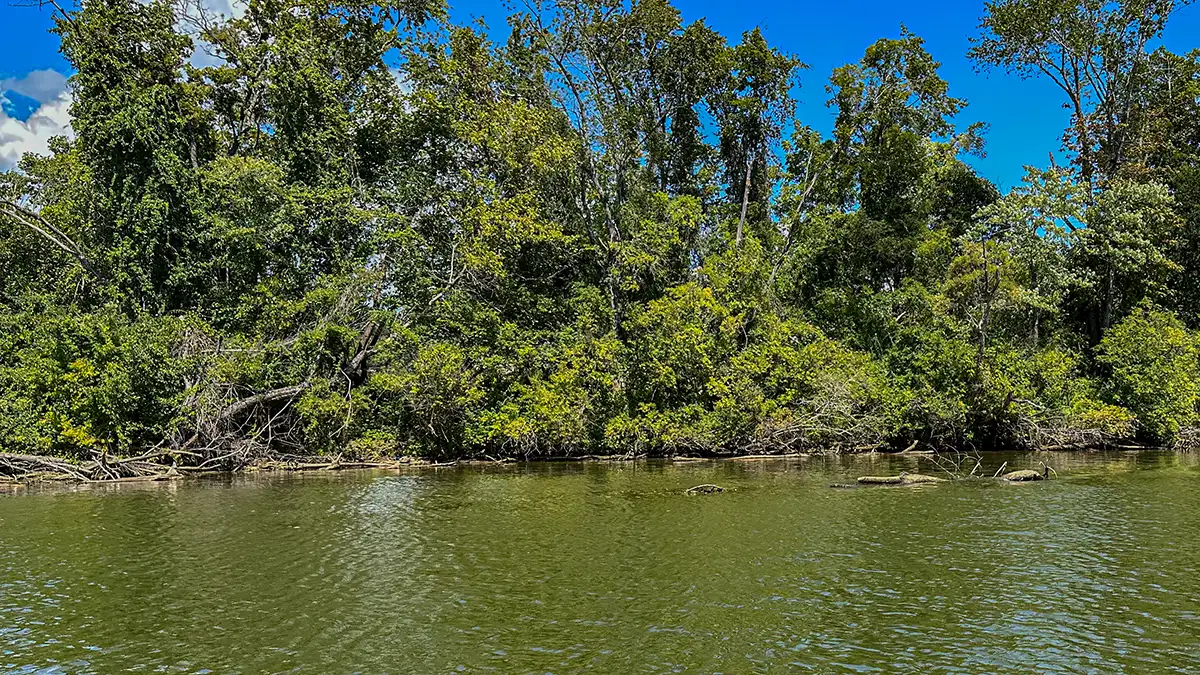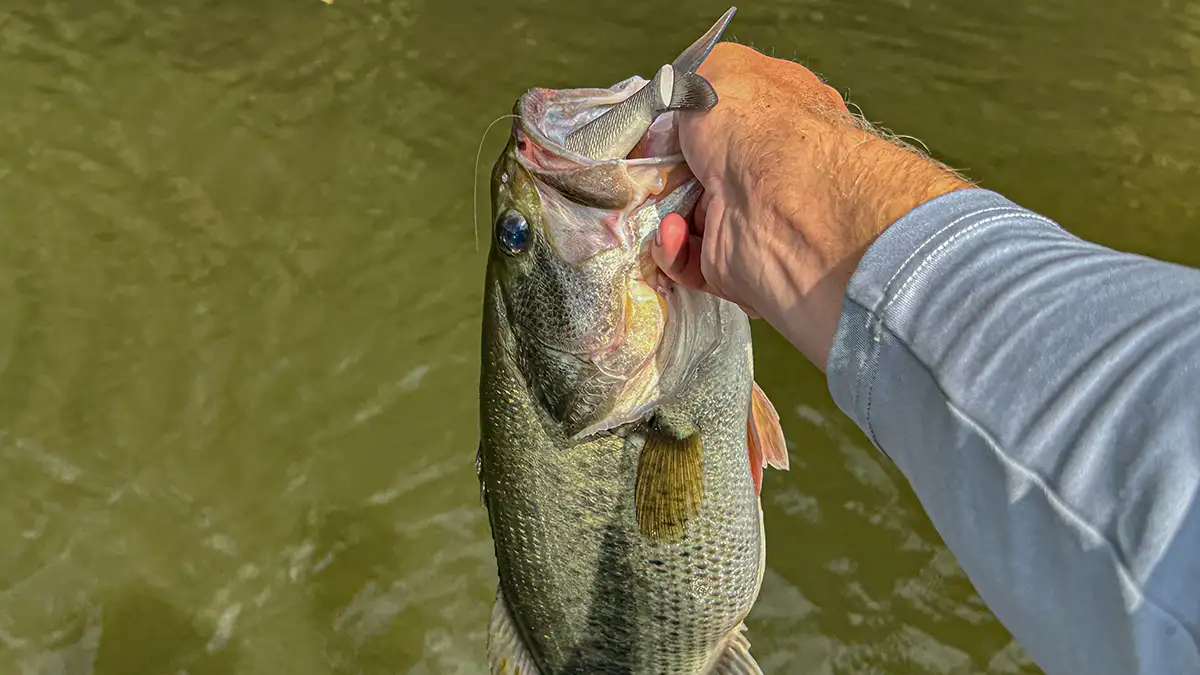River fishing is a great way to get away from the crowded lakes and enjoy some time in nature. Along with the beautiful scenery, America’s 3 1/2-million miles of river and streams hold some of the best fishing our great nation has to offer. Exploring these river systems is a great way get out in nature and catch some quality bass.
Unlike big natural lakes and expansive man-made reservoirs, you don’t need a boat and tons of dollars in fish finders to catch fish. Instead, all you need is a rod, a small bag of lures and your own two feet. Fishing these rivers can be simple once you understand when to go, where to go and what to throw on these bodies of water. They are perfect for kayaks and small boats as well. But rivers offer a lot of fishing options and accessibility to a lot of different types of anglers.
LAKES VS. RIVERS
While many of the same species reside in both lakes and rivers, the fishing styles often vary. The biggest difference between fishing a lake and a river is the presence of current. Current forces fish up against cover, causing them to constantly reposition based on the currents strength. This typically leads to a more shallow oriented fishery. This current keeps fish from roaming offshore, often negating the use of electronics. Rivers are much shallower than the typical lake as well, this can make navigating a boat challenging depending on the specific river. And river current can also dictate feeding behavior in very predictable ways that you can visually identify as you work your way down the river.
Lakes however are much deeper, typically consisting of various types of offshore structure and shallow cover. This can drastically change the fishing style compared to a fast moving river system. In lakes, fish will often position both shallow and offshore, relate to a wide variety of areas, cover and bait fish populations. This allows for electronics to play a major role in big water fishing. These bodies of water are often more crowded as well, typically leading to a more pressured fishery.
WHEN TO FISH A RIVER
While lakes are often more pressured, the largest caliber of fish tend to reside in these bodies of water. This means that when fishing is at its best, the main lake is typically your better option. However, when fishing slows you can often have a much better day by targeting these shallow water river systems or way up the river on a larger lake or reservoir. While the largest bass live in the lake, your average bite up a river is typically still a solid fish. This is due to current forcing fish to constantly swim and eat to survive, ultimately leading to a healthy population of fish.
Looking at the current season and weather conditions are great ways to decide when to fish a river. During the spring, the largest fish in the lake move shallow to spawn. During this time fishing is typically at its best, making the main lake pockets and bays better options. However, once fishing slows later in the summer, the biggest bags often come from up the river.
My favorite time to fish rivers is during the fall and early winter months. During the fall, fish are in a transitional period, which can make fishing on the main lake tough. The cooler temperatures will also force fish into the muddier shallow water in search of warmth. This is the perfect time to run up a river and target these shallow water bass.
WHERE TO FISH
Deciding where to fish on your local river system can be fairly simple depending on what kind of cover is present. Some of the most common types of cover are laydowns, shoals, big rocks or boulders and bluff or steep bank swings. All of these can be fantastic options to catch quality bass depending on the current conditions.
Targeting laydowns is typically best before the river gets low in the early winter. Fish will position themselves behind this cover to ambush bait getting pushed down river by the current. This is the perfect location to target shallow water bass in current. While laydowns can be a super high percentage area in rivers across the United States, low water levels often forces fish into deeper water away from these laydowns. This is the perfect time to transition over to fishing steeper swings and bluffs.
Bluff walls are a great location to fish as the water levels reach winter pool. This low water level forces the majority of cover out of the water, making bluff walls nearly the only option. Current can help position these fish to feed by pushing bait up against the wall. Throwing a jerkbait is a great way to trigger a reaction strike from bass feeding on shad in these locations.
Lastly, shoals can be another extremely productive area regardless of the water level. These shoals are made up of high spots and boulders that create under water current breaks across the river. Fish will sit behind these current breaks and wait for forage to be washed up over the rocks. Shoals funnel current and make fish feeding predictable. This is the perfect ambush point for fish to feed on bait and is a super productive location to fish.
WHAT TO THROW
Deciding what to throw is the next step in having a successful day river fishing. There is a plethora of different baits you can catch bass on in these river systems. However, three I always keep honest are the ned rig, jig and glide bait. All three of these lures can be extremely productive on rivers across the country given the right weather conditions. And of course there are always times where other lures like spinnerbaits, shallow crankbaits and even topwaters will produce on rivers in high percentage areas.
A Z-Man TRD Ned rig tends to be my most consistent river bait. I’ve caught everything from drum to largemouth on the bait, and it’s a fantastic choice for catching lots of numbers. Some of the most productive locations to fish this bait are around bluff walls and shoals. The ned rig closely resembles many different types of forage that use this rock as protection, and is a great way to trick finicky bass into biting.
A jig is another river fishing staple that catches bass all over the county. This bait is perfect when fishing around heavy structure or other locations with lots of snags. One of my favorite places to throw this bait is in laydowns on channel swing banks. The added current in these areas will often position fish in laydowns to feed, making it a great high percentage location to flip a jig. This bait is also a great option when the water is muddy and you need to displace some water. My go to river jig is the D&L Advantage Casting Jig.
Lastly, one of my favorite baits to throw in rivers is a glide bait. This bait has a ton of drawing power and is great for targeting aggressive bass. This bait really excels in clear water where fish can see the bait from long distances. I like to throw this bait around laydowns, bluffs and other types of shallow water structure. This bait is often responsible for catching some of the biggest fish in numerous river systems across the country. My go to river glide bait is the MM26 Herring Glide and the Spro KGB Chad Shad 180. I have had a lot of success catching shoal bass on rivers with glide baits.
Not only is river fishing a super fun way to fish, but it is super accessible regardless of your vessel. Some of the best ways to access these types of fisheries is by wading or floating them in a kayak. If you’re looking for a fun and affordable way to catch some quality bass, I would highly recommend giving river fishing a try.















